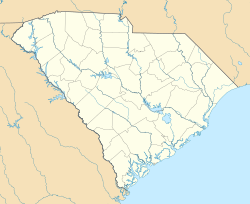Circular Congregational Church
|
Parish House of the Circular Congregational Church
|
|

Parish House of the Circular Church
|
|
| Location | 150 Meeting Street, Charleston, South Carolina |
|---|---|
| Coordinates | 32°46′44″N 79°55′52″W / 32.77889°N 79.93111°WCoordinates: 32°46′44″N 79°55′52″W / 32.77889°N 79.93111°W |
| Built | 1806 (parish house) 1892 (church) |
| Architect |
Robert Mills (parish house) Stephenson & Greene (church) |
| Architectural style | Greek Revival, Romanesque |
| Part of | Charleston Historic District (#66000964) |
| NRHP Reference # | 73001683 |
| Significant dates | |
| Added to NRHP | November 7, 1973 |
| Designated NHL | November 7, 1973 |
| Designated NHLDCP | October 9, 1960 |
The Circular Congregational Church is a historic church at 150 Meeting Street in Charleston, South Carolina, United States, used by a congregation established in 1681. Its parish house, the Parish House of the Circular Congregational Church, is a highly significant Greek Revival architectural work by Robert Mills, and is recognized as a U.S. National Historic Landmark.
The congregation was co-founded with Charles Towne, 1680–1685, by the English Congregationalists, Scots Presbyterians, and French Huguenots of the original settlement. These "dissenters" erected a Meeting House in the northwest corner of the walled city. The present sanctuary occupies that exact site. The street leading to it was called "Meeting House Street," later shortened to Meeting Street.
The earliest records of the church were lost when a hurricane swept them from the manse, located at White Point (the Battery), in 1713. During the colonial period, this unusual church had no official name, but "suffered itself to be called either Presbyterian, Congregational, or Independent: sometimes by one of the names, sometimes by two of them, and at other times by all three. We do not find that this church is either Presbyterian, Congregational, or Independent, but somewhat distinct and singular from them all."
Many of the early ministers hailed from Scotland, England, Wales, and New England. The "old White Meeting House" was enlarged in 1732, only a year after 12 Scots families moved down the street to start the First (Scots) Presbyterian Church with a stricter Presbyterian government and doctrine. While many Presbyterians remained, the policy of this church "was not so much to define exactly a particular mode of their discipline, and to bind their hands up to any one stiff form adopted either by Presbyterians, Congregationalists, or Independents, as to be upon a broad dissenting bottom, and to leave ourselves as free as possible from any foreign shackles, that no moderate persons of either denomination might be afraid to join them. ”
Shaped by its independent mind and goaded by a colonial government that treated “dissenters” (non-Anglicans) with contempt, the church became a greenhouse for revolutionary sentiment in the colony. Prominent members of the Meeting House, and its distinguished minister, William Tennent (1772–1777), were frequently heard speaking for political and religious freedom. Tennent took his life in his hands when he made a wide tour of the Carolina back-country in 1775 to gain subscribers for the cause of independence.
...
Wikipedia


